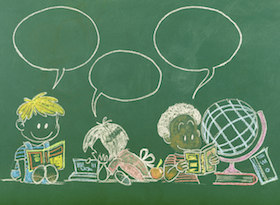Overview of Speech Disorders

What Is Speech?
Speech is how we say sounds and words.
Articulation
How we make speech sounds using the mouth, lips, and tongue.
Voice
How we use our vocal folds and breath to make sounds. Our voice can be loud or soft or high- or low-pitched.
Fluency
This is the rhythm of our speech.
What are common Speech Disorders?
Articulation involves the physical production of speech sounds. A child with a speech sound disorder will have difficulty articulating certain speech sounds. This can make the child hard to understand.
- Omissions: A child may leave out sounds in words and sentences.
- Substitutions: A child may use an incorrect sound instead of the correct one.
- Distortions: A child tries to make the right sound, but cannot produce it clearly.
-
Why do they occur?
- Oral Apraxia: The child may have difficulty making voluntary movements of the tongue and lips, and will have trouble combining these movements needed to make speech sounds. As a result, a child’s speech may be difficult to produce and there are often many inconsistent articulation errors in connected speech.
- Dysarthria: The child my show paralysis, weakness, or generally poor coordination of the muscles of the mouth.
-
When do I know that my child is delayed in speech?
- If the child doesn’t babble using consonant sounds (particularly b, d, m, and n) by age 8 or 9 months.
- If the child does not produce one word other than mama or Dada by 12 months.
- If the child uses mostly vowel sounds and gestures for communication after 18 months.
- If the child’s speech cannot be understood by strangers at the age of 3 years.
- If the child often leaves out consonant sounds from words at the age of 3 years.
- If the child’s speech is still difficult to understand at the age of 4 years.
- If the child is still not able to produce most speech sounds by the age of 6 years.
- If the child is distorting sounds such as /s/ and /r/ after the age of 6 or 7 years.
- If the child is embarrassed or worried about his speech at any age.
Fluency is the natural “flow” or forward movement of speech. A fluency disorder, or stuttering or commonly known as stammering, is when speech shows an abnormal number of repetitions, hesitations, prolongations, or disturbances in this rhythm or flow. Tension may also be seen in the face, neck, shoulders, or fists.
Environmental reactions to normal disfluencies can result in stuttering.
-
When do I suspect articulation disorder in my child?
- When the child’s speech seems to have many repetitions, hesitations, prolongations, blocks, or disruptions.
- If the child appears tense during speech.
- If the child avoids speaking due to a fear of stuttering.
- If the child considers himself to be someone who stutters.
Voice Disorders
The voice may be harsh, hoarse, raspy, cut in and out, or show sudden changes in pitch with phonation disorders.
Resonance Disorders
Resonance disorders are caused by an imbalance in sound energy as the voice passes through the spaces of the throat, nose, or mouth. In this their child’s voice sounds ‘nasal’.
-
Red Flags:
- If the voice is hoarse, harsh, breathy, or of poor quality.
- If the voice is always too loud or too soft.
- If the voice is too high or too low for the child’s age or sex.
- If the voice often breaks or suddenly changes pitch.
How do I treat my child?
Early intervention is very important for children with communication/speech & language disorders. Treatment is the most effective if started early.
Testing can be done even in infants. In infancy, the therapist works with the parents on stimulating speech and language development in the home. Individual therapy is usually begun between the ages of 2 and 4.
Children learn speech and language skills by listening to others, and practicing as they talk. Parents are the most important teachers for their child in the early years.
Parents can help by creating lots of opportunities to listen and to talk. This can be done by frequently pointing out and naming important people, places, and things, reading to the child and talking throughout the day, especially during daily routines and favorite activities. Parents can give the child models of words and sentences to repeat.
Parents can also set up opportunities for the child to answer questions and talk. Listening to music, singing songs, and sharing nursery rhymes and finger plays are also great ways to build speech and language while having fun with your child.

Overview of Language Disorders in Children
What are language disorders?
A language disorder can mean inability to find the right words or make clear sentences or difficulty in understanding language. The child may have trouble answering even simple questions. Without treatment, this communication problem can continue and lead to emotional and academic struggles.
Receptive language disorders involve difficulty understanding what others are saying.
Expressive language issues involve difficulty expressing thoughts and ideas.
What are the causes?

Genes and heredity: 20 to 40 percent of children with a family history of speech and language impairment have the condition.
Other genetic disorders – Autism spectrum disorder, Down syndrome, intellectual disabilities and premature birth might also cause
Symptoms of language disorders –
-
Expressive language disorders-
- Has a limited vocabulary.
- Frequently says “um”.
- Substitutes general words like “stuff” and “things” for more precise words.
- Has trouble learning new vocabulary words.
- Leaves out key words and confuses verb tense.
- May not talk much or often, but understands what other people say.
- Uses a limited variety of sentence structures when speaking.
What skills are affected by language disorders?
a. Social skills: They may become shy or distant.
b. Academic struggles: They can have reading issues. Some kids also struggle with writing.
Red flags for receptive language delay
- At 15 months, does not look or point at people or objects when they are named by a parent or caregiver.
- At 18 months, does not follow simple directions, such as “get your coat”.
- At 24 months, is not able to point to a picture or a part of the body when it is named.
- At 30 months, does not respond out loud or by nodding or shaking the head and asking questions.
- At 36 months, does not follow two-step directions, and does not understand action words.
Red flags of expressive language delay
- At 15 months, is not using three words.
- At 18 months, is not saying, “Mama,” “Dada,” or other names.
- At 24 months, is not using at least 25 words.
- At 30 months, is not using two-word phrases, including phrases with both a noun and a verb.
- At 36 months, does not have at least a 200-word vocabulary, is not asking for items by name, repeats exactly questions asked by others, seems to have lost some language skills, or is not using complete sentences.
- At 48 months, often uses words incorrectly or uses a similar or related word instead of the correct word.

Steps of Evaluation
- Hearing evaluation.
- Psychological evaluation- For DQ/IQ and screening for ASD.
- Speech & language evaluation- A proper evaluation by a speech therapist involves testing your child for both “receptive language” (the ability to understand what others say) and “expressive language” (the ability to express thoughts).
What conditions often come with to language disorders?
- Reading issues – Dyslexia is common among kids with mixed receptive-expressive language issues.
- ADHD – Research has shown a link between language disorders and ADHD. They may also have anxiety disorders, and oppositional defiant disorder (ODD) & conduct disorder.
How do I treat my child with language disorder?
- Speech Therapy: A speech therapist can work one-on-one with your child to build his vocabulary and improve his grammar. The therapist will also show you how to work with your child at home.
- Psychotherapy: If your child has emotional difficulties because of language issues, he may need psychotherapy.
Teachers Accommodation
- Model the desired behavior. When the child answers a question with a one-word sentence, the teacher responds by modeling back with a full, correct sentence, so that the child hears the words in correct order.
- Give choices. Instead of asking your child open-ended questions, the teacher can ask either-or questions, so your child must choose the correct one.
- Plan. Teachers tell students in advance that they’ll be called on. This gives kids more time to compose their thoughts.
Home strategies
- Model the desired bCommunicate with your child as much as you can. During the early childhood years, sing and play lots of music. Talk about what you see when you’re driving in the car or at the supermarket. Listen to your child. Give your child plenty of time to respond, and resist the temptation to jump in and fill the silence.
- Make reading an interactive experience. Discuss the book’s pictures, and let your child make up a new ending or act out the story with puppets. Read to your child and encourage nursery rhymes.
